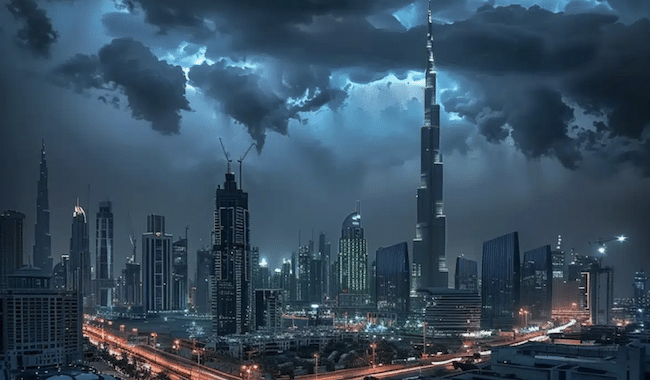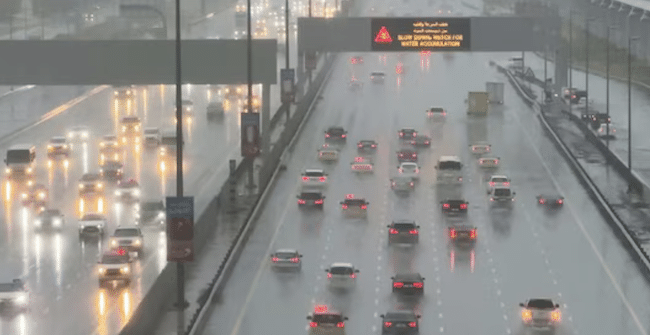Artificial rain in Dubai is an innovative technique adopted by the United Arab Emirates to meet the challenges of climate change.
This article draws its information from a team of local experts, guaranteeing up-to-date and accurate data. The metropolis uses sophisticated methods such as cloud seeding to induce precipitation.
This is particularly crucial in an environment where water is a scarce resource.
Cloud seeding involves dispersing substances into the atmosphere which cause water to condense, thereby increasing the likelihood of rain.
In Dubai, this technique is part of a broader water resource management strategy, and represents a rapidly expanding field of scientific study and application.
Initiatives to introduce artificial rainfall raise both the hope of better climate control and questions about the environmental risks and impacts associated with such interventions.
Key points
- Dubai's artificial rain technique combats water shortage by seeding clouds.
- It is part of an overall strategy to improve the management of the region's water resources.
- Artificial rain raises questions about its effectiveness and impact on the environment.
The Cloud Seeding Process in Dubai
Based on information provided by local experts, cloud seeding in Dubai is an advanced weather modification technique aimed at increasing rainfall in this arid region.
Techniques and technologies used
L'cloud seeding in Dubai mainly uses drones equipped with sophisticated technology to disperse electric charges in the clouds.
This method stimulates condensation and rain formation. Scientists at the National Meteorological Center orchestrate these operations, ensuring that the dispersion of substances such as silver iodide or salt is optimized for the efficient formation of precipitation.
International Partnerships and Case Studies
The National Meteorological Center is collaborating with international climatologists to examine the effectiveness and impact of cloud seeding.
This partnership enables the evaluation of specific cases where this technique has been used, notably to mitigate the effects of a storm or to supply water to a region during a period of drought. These case studies are crucial for refining methods and minimizing any potential ecological impact.
Impacts and Challenges of Artificial Rainfall
The implementation of artificial rain in Dubai addresses critical environmental issues, supported by our team of local experts who identify the benefits and challenges associated with this technology.
Economic and environmental benefits
Artificial rain is an innovative way to bridge the water gap of the region, which has been particularly hard hit by drought. Here are the main advantages:
- Agriculture : Enables crops to survive in arid regions, boosting the local economy.
- Groundwater recharge : Contributes to increasing drinking water reserves.
- Lower temperatures : Moderates local heatwaves exacerbated by global warming.
- Combating desertification : Helps stabilize soil and promote fertility.
Challenges and controversies
However, the use of artificial rain raises important questions and challenges:
- Meteorological ethics : Questions about climate manipulation.
- Environmental impact : Long-term effects on local ecosystems still unknown.
- Flooding: Increased risk of sudden torrential rains.
- Cost : Economic viability of the process for governments and local players.
- Climate change : Need to adapt this technique to the more extreme weather phenomena caused by global warming.
Frequently asked questions
Our team of local experts will provide you with the most accurate answers about artificial rain and its implications in Dubai.
What techniques are used to create artificial rain in Dubai?
To generate artificial rain, Dubai uses cloud seeding. This technique involves dispersing substances, such as silver iodide, into the clouds to stimulate condensation and rain.
What are the risks involved in creating artificial rain?
Although cloud seeding can increase the amount of rainfall, there are concerns about its long-term ecological and meteorological effects. The likelihood of flooding and changes to natural precipitation cycles are notable risks.
Can artificial rain cause flooding in Dubai?
Yes, artificial rain can cause flooding, especially if the volume of water generated exceeds the absorption capacity of urban soil and drainage systems, as observed during recent storms.
How is cloud seeding carried out in Dubai?
Cloud seeding in Dubai is carried out by specially equipped aircraft that release chemicals such as silver iodide into the clouds to induce precipitation.
What impact have the recent storms had on Dubai?
Recent storms accentuated by cloud seeding have led to extreme precipitation, causing traffic disruption, infrastructure damage and an impact on residents' daily lives.
Why do we trigger artificial thunderstorms in Dubai?
Artificial thunderstorms are triggered in Dubai for two main reasons. The first is to compensate for the lack of natural rainfall in this arid region. The second is to replenish the country's scarce freshwater reserves.
What to do in Dubai in 1 day, 2 days, 3 days, 5 days, a week?
Whatever the length of your stay, I invite you to download my special Dubai guide.
It's free and in PDF format.
All you have to do is tell me below which e-mail address you'd like to receive it at.
EDIT: you can't enter your email?
Take the quiz at the top of this article and you'll be able to register your email address to receive the special Dubai guide!


Leave a Reply